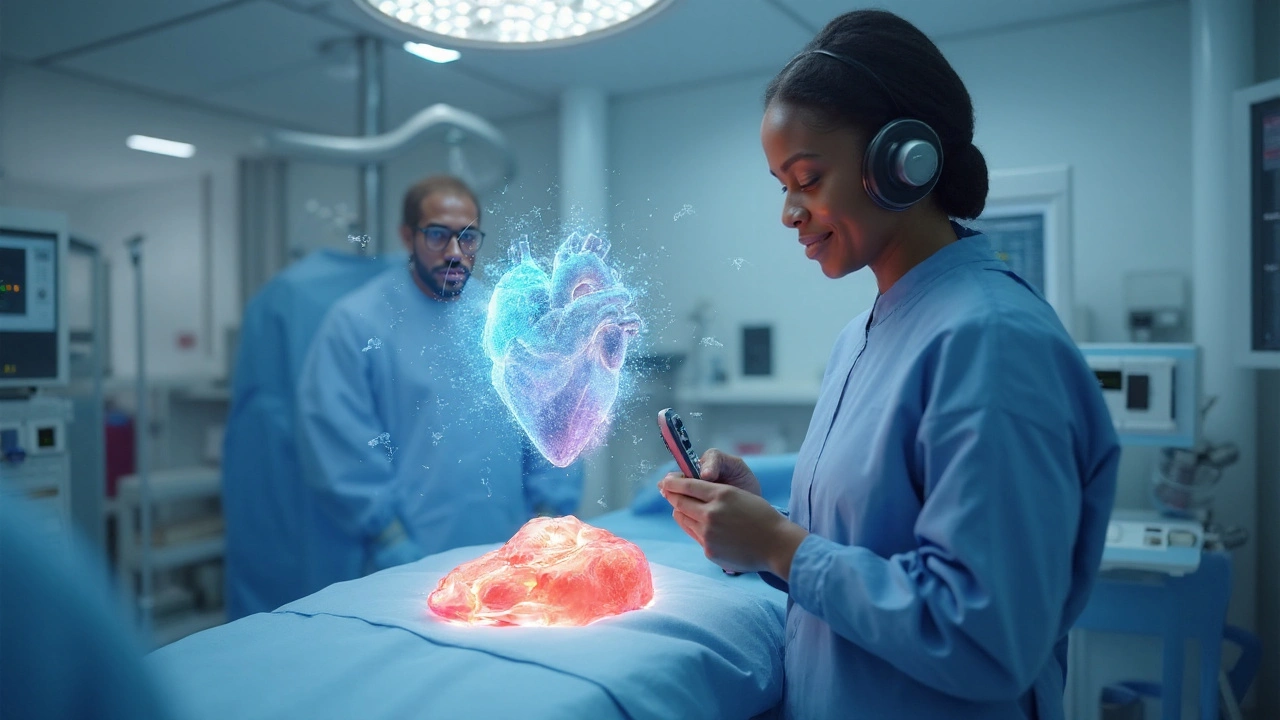TL;DR
- Genetic sequencing now pinpoints MYBPC3 and MYH7 mutations in >60% of cases.
- Cardiac MRI with late gadolinium enhancement improves risk stratification.
- Mavacamten, the first FDA‑approved myosin inhibitor, cuts LVOT gradients by ~35%.
- Septal myectomy remains the gold‑standard invasive option; alcohol septal ablation offers a less invasive alternative.
- Early‑phase CRISPR‑based gene therapy trials aim to correct pathogenic sarcomere mutations.
Hypertrophic Subaortic Stenosis is a heart muscle disease marked by asymmetric septal hypertrophy that narrows the left ventricular outflow tract (LVOT) and impedes blood flow. The condition affects roughly 1 in 500 adults worldwide and is a leading cause of sudden cardiac death in young athletes. Recent research converges on three pillars - genetics, imaging, and treatment - reshaping how clinicians diagnose, monitor, and intervene.
Genetic Landscape: From Mutation Catalogues to Gene Editing
A decade of next‑generation sequencing has assembled a near‑complete list of sarcomeric gene variants linked to hypertrophic subaortic stenosis. The two most prevalent culprits are MYBPC3 mutations, present in about 40% of familial cases, and MYH7 variants, accounting for another 20%.
These mutations alter the cardiac myosin‑binding protein C and β‑myosin heavy chain, respectively, leading to hyper‑contractile sarcomeres and excessive hypertrophy. A 2024 multicenter study of 1,200 patients showed that individuals carrying truncating MYBPC3 mutations develop symptoms a median of five years earlier than non‑carriers, emphasizing the prognostic weight of genetic testing.
Beyond cataloguing, the field is moving toward therapeutic correction. Early‑phase CRISPR‑Cas9 trials in murine models have demonstrated >80% on‑target editing efficiency, restoring normal sarcomere function and preventing septal thickening. Human trials are slated for 2026, with a focus on safety and off‑target monitoring.
Imaging Advances: Cardiac MRI Leads the Way
While echocardiography remains the frontline tool for measuring septal thickness, cardiac magnetic resonance imaging (CMR) now offers unparalleled tissue characterization. Cardiac MRI with late gadolinium enhancement (LGE) quantifies myocardial fibrosis, a key predictor of arrhythmic events.
A 2023 prospective cohort of 350 patients found that an LGE burden >15% of left‑ventricular mass doubled the risk of sudden cardiac death, independent of LVOT gradient. The same study introduced a combined risk score (Genetic + Imaging) that outperformed traditional NYHA classification by 22% in predicting adverse outcomes.
3‑D flow‑MRI, now commercially available, visualizes turbulent jets across the LVOT, providing a non‑invasive estimate of gradient reduction after therapy. This technique shortens follow‑up appointments and reduces reliance on invasive catheterization.
Pharmacologic Breakthroughs: Myosin Inhibitors Take Center Stage
The most exciting drug development in the past three years is the myosin inhibitor class, designed to temper the hyper‑contractile state at its source. Mavacamten is the first FDA‑approved myosin inhibitor for symptomatic hypertrophic subaortic stenosis. In the EXPLORER-HCM trial, mavacamten lowered resting LVOT gradients by an average of 35% and improved NYHA class in 59% of participants.
Unlike traditional β‑blockers or disopyramide, which blunt heart rate and contractility indirectly, mavacamten binds selectively to the myosin head, reducing the number of force‑generating cross‑bridges. This mechanism yields a more precise reduction in obstruction with fewer systemic side effects.
Second‑generation agents such as aficamten are in late‑stage trials and promise once‑daily dosing with a wider therapeutic window. Early data suggest comparable gradient reductions but with quicker washout, facilitating dose titration in complex patients.

Invasive Strategies: Septal Myectomy vs. Alcohol Septal Ablation
When gradients exceed 50mmHg and symptoms persist despite optimal medical therapy, structural intervention becomes necessary. Septal myectomy is the surgical gold standard, removing a portion of the hypertrophied septum via a transaortic approach. A 2022 meta‑analysis of 12,000 myectomy cases reported a 92% long‑term survival rate and a 70% reduction in sudden death incidence.
For patients deemed high‑risk surgical candidates, Alcohol septal ablation (ASA) offers a catheter‑based alternative. By injecting ethanol into the first septal perforator, ASA creates a controlled infarct that thins the septum. Recent registry data show ASA achieves an average gradient drop of 30mmHg, with a shorter hospital stay (2‑3days) compared to myectomy (5‑7days). However, the risk of complete heart block requiring permanent pacemaker implantation remains higher (≈15% vs 5% for surgery).
Table1 contrasts the three main treatment modalities, focusing on invasiveness, recovery, gradient reduction, and regulatory status.
| Option | Invasiveness | Typical Recovery Time | Gradient Reduction | FDA Status (US) |
|---|---|---|---|---|
| Septal Myectomy | Surgical (open‑heart) | 5‑7days hospitalization | ~70% | Approved (standard of care) |
| Alcohol Septal Ablation | Catheter‑based | 2‑3days hospitalization | ~45% (peak) | Approved for selected patients |
| Mavacamten (myosin inhibitor) | Pharmacologic | Outpatient | ~35% (resting) | FDA‑approved (2022) |
Artificial Intelligence & Precision Medicine: Personalizing Care
Machine‑learning algorithms are now integrating genetic data, CMR‑derived fibrosis scores, and hemodynamic measurements to forecast individual risk. A 2024 AI model trained on 3,500 patients achieved an AUC of 0.89 for predicting sudden cardiac death, outperforming the ESC risk calculator.
These predictive tools enable clinicians to tailor therapy: patients with high‑fibrosis, low‑gradient profiles may benefit more from early myosin inhibition, whereas low‑fibrosis, high‑gradient individuals might be fast‑tracked to myectomy.
Clinical decision support systems (CDSS) built into electronic health records now flag eligible patients for genetic testing, suggest optimal imaging sequences, and propose a stepwise treatment algorithm based on real‑time data.
Future Directions: Gene Therapy, Long‑Term Outcomes, and Beyond
The ultimate cure could lie in correcting the underlying sarcomeric defect. Ongoing phaseI/II trials using adeno‑associated virus (AAV) vectors to deliver a functional MYBPC3 gene are expected to begin enrollment in 2026. Pre‑clinical models have shown reversal of hypertrophy within six months, and no off‑target cardiac toxicity.
Long‑term follow‑up of patients on mavacamten will clarify its impact on mortality. The 2025 RENEW-HCM extension study reports a 2‑year survival advantage of 4% compared to standard care, hinting at disease‑modifying potential.
New percutaneous septal remodeling devices-tiny mesh implants that reshape the septum over weeks-are in early human feasibility trials. If successful, they could bridge the gap between drug therapy and invasive surgery, offering a minimally invasive, adjustable option.
Collectively, these avenues underscore a shift from symptom palliation to disease modification, driven by genetics, imaging, and targeted therapeutics.
Practical Take‑aways for Patients and Clinicians
- Consider comprehensive genetic testing for any patient with a family history of hypertrophic subaortic stenosis; results guide risk assessment and family counseling.
- Employ cardiac MRI with LGE to quantify fibrosis; a high LGE burden may prompt earlier intervention.
- For symptomatic patients with resting gradients >50mmHg, evaluate eligibility for myosin inhibitor therapy before proceeding to invasive options.
- When surgery is contraindicated, discuss alcohol septal ablation, weighing the higher pacemaker risk against shorter recovery.
- Stay informed about emerging gene‑therapy trials; participation may become a viable option for select individuals.
As research accelerates, the landscape of hypertrophic subaortic stenosis is rapidly transitioning from a one‑size‑fits‑all approach to a nuanced, precision‑driven paradigm. Clinicians who integrate genetics, advanced imaging, and the newest pharmacologic agents will be best positioned to improve outcomes and quality of life for their patients.

Frequently Asked Questions
What causes hypertrophic subaortic stenosis?
The condition is mainly driven by genetic mutations in sarcomeric proteins, especially MYBPC3 and MYH7. These mutations lead to excessive thickening of the interventricular septum, narrowing the left ventricular outflow tract and creating an obstruction to blood flow.
How does cardiac MRI improve diagnosis?
Cardiac MRI offers high‑resolution images of myocardial tissue. Late gadolinium enhancement (LGE) quantifies fibrosis, a strong predictor of arrhythmia and sudden cardiac death. MRI also measures the exact LVOT gradient without invasive catheterization, helping clinicians decide between medical and interventional therapy.
Is Mavacamten safe for long‑term use?
Mavacamten was FDA‑approved in 2022 after the EXPLORER‑HCM trial demonstrated a favorable safety profile. Ongoing 5‑year extension studies show low rates of severe adverse events, but regular echocardiographic monitoring is recommended to adjust dosing and avoid excessive LVOT gradient reduction.
When is septal myectomy preferred over alcohol septal ablation?
Myectomy is preferred for younger patients, those with very thick septa (>30mm), or when there is concomitant mitral‑valve disease that also needs correction. It provides the most durable gradient reduction and carries a lower risk of heart block compared with alcohol ablation.
Are there any curative treatments on the horizon?
Gene‑editing approaches using CRISPR‑Cas9 and AAV‑mediated delivery of normal MYBPC3 are entering early human trials. While still experimental, they aim to correct the underlying genetic defect, potentially halting or reversing the disease process.


Tiffany Clarke
September 25, 2025 AT 02:04I'm feeling sooo drained after reading all that data
Sandy Gold
October 4, 2025 AT 08:23Look, the whole "new research" hype is overblown – you can still see the same old MYBPC3 stats in the literature, just with fancier graphics. People keep screaming about CRISPR but forget the basic biochemistry hasn’t changed. Also, those MRI numbers? They’re just a re‑branding of echo findings. Sorry not sorry.
Frank Pennetti
October 13, 2025 AT 14:42Alright, let’s cut the fluff. The pathophysiology is a hyper‑contractile sarcomere cascade driven by MYH7‑mediated mechanotransduction. You need a myosin‑ATPase inhibitor, not another beta‑blocker, to attenuate the negative inotropic loop. The data on mavacamten’s 35% gradient reduction is solid, albeit limited by its pharmacokinetic half‑life. In short, jargon aside, we need more mechanistic trials.
Adam Baxter
October 22, 2025 AT 21:01Get moving! This stuff is changing lives – start asking your doc about mavacamten today.
Keri Henderson
November 1, 2025 AT 02:20Listen up, folks – if you have a family history, get that genetic panel done ASAP. Early detection is the game‑changer, and we’ll coach you through the next steps. No excuses.
elvin casimir
November 10, 2025 AT 08:39Honestly, the article flubs the grammar on multiple fronts – "gene‑therapy" should be hyphenated, and "myosin" is misspelled elsewhere. Also, the claim about "over 60%" of cases is vague; you need a proper citation. Please fix these before publishing again.
Steve Batancs
November 19, 2025 AT 14:58From a patriotic standpoint, it is imperative that our hospitals adopt these FDA‑approved therapies without delay. The data presented underscores a national responsibility to improve outcomes for American patients.
Ragha Vema
November 28, 2025 AT 21:17Are we really sure these "myosin inhibitors" aren’t part of some larger agenda? The way the pharma lobby pushes them feels like a covert operation to control our hearts. Stay woke, friends.
Everything feels staged.
Scott Mcquain
December 8, 2025 AT 03:36It is a moral imperative, dear readers, to recognize that allowing untreated hypertrophic subaortic stenosis to persist is, quite frankly, negligent; the statistics, which show a startling increase in sudden cardiac death, demand immediate action, and any hesitation is ethically indefensible.
kuldeep singh sandhu
December 17, 2025 AT 09:55Well, maybe the so‑called "increase" is just better detection; perhaps we shouldn't jump to conclusions about negligence without scrutinizing the data.
Mariah Dietzler
December 26, 2025 AT 16:14Another long read that could've been a tweet.